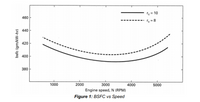
Elements Of Electromagnetics
7th Edition
ISBN: 9780190698614
Author: Sadiku, Matthew N. O.
Publisher: Oxford University Press
expand_more
expand_more
format_list_bulleted
Question
Using the basic relations given below and detailing your method and assumptions,
Develop all the analytical relations required to:
1) Determine the temperatures and pressures at all stages of an ideal air-standard SI
Otto cycle analysis
2) Show that the thermal efficiency of any internal combustion engine can be
simplified as a ratio of temperature differences
3) Discuss the concept of Brake Specific Fuel Consumption (BSFC) and propose a rationale for the Figure 1 below (in other words, explain why the BSFC is decreasing
before increasing with engine speed)

Transcribed Image Text:rc = 10
460
re = 8
440
420
400
380
1000
2000
3000
4000
5000
Engine speed, N (RPM)
Figure 1: BSFC vs Speed
bsfc (gm/kW-hr)

Transcribed Image Text:Question 1
Using the basic relations given below and detailing your method and assumptions,
Tout = C, (T, –T,)
PV,
т,
PV" = constant (isentropic)
RT
RT,
P
W.
net,out
where w,
W.
net out
Nth
net,out = Tin - Iout
МЕР
where
Tin
W.
n = 2-
m,w
sfc :
m,W net
net
net
Expert Solution
This question has been solved!
Explore an expertly crafted, step-by-step solution for a thorough understanding of key concepts.
This is a popular solution
Trending nowThis is a popular solution!
Step by stepSolved in 4 steps with 1 images

Knowledge Booster
Learn more about
Need a deep-dive on the concept behind this application? Look no further. Learn more about this topic, mechanical-engineering and related others by exploring similar questions and additional content below.Similar questions
- Q.1 formula (CH19O..1) produces 300 Nm @ 2400 rpm. The displacement volume of the engine is 2 litres and A 4-stroke, 4-cylinder diesel engine operating with bio-diesel fuel with an equivalent molecular the intake air flow rate is 69.6 g/s. LHV of fuel is 41 MJ/kg. Measurement of the engine exhaust gives the following volumetric concentrations: 200 ppm CO 32 mg soot / m of exhaust Assuming a brake thermal efficiency of 40%, density of exhaust as 1.15 kg/m' and molar mass of exhaust as 29 kg/kmol, determine the soot and CO emissions in g/kWharrow_forwardPart (a) Find the efficiency of an ideal engine operating between these reservoirs. Remember the efficiency is unit-less, therefore so should your number be as well. ( Party a was incorrect can you try again ) Part (d) What if the actual work done (more realistically) is W = 290 J during a single cycle; what is the efficiency of this engine if the energy input is the same (again, the number should be unit-less)? Part (e) What is equation for the new power output per cycle (in Watts) of this new (and more realistic) engine?arrow_forwardPlease don't provide handwritten solution .......arrow_forward
- I am having a hard time understanding C-E on this problem. For C, I know that Th>Ti>Tc. Does that mean that since ec= 1-Tc/Th and Tc is the lowest temp of the system, that it is indeed more efficient with both engines? The other ones, I just don't know where to start. Any help or explantions would be appreciated!arrow_forwardd. Analysis of the Diesel Cycle[Explain the Derivation of the following in relation to the diagram]: 1.) QA 2.) Qr 3.) W 4.) thermal efficiency - e 5.) the compression ratio - rk 6.) the cut off ratio - rc 7.) Derivation of the formula for e Process 1-2 Process 2-3 Process 3-4 8.) Relation among rk, rc, and re(expansion ratio)arrow_forwardWhat is the advantage of nitriding? Select all correct answers. Some complex components can be nitride without difficulty. Better wear resistance. Better fatigue resistance. The cheapest method of case hardening. What is the correct definition of plastic deformation? The behavior of a material when its size changes by the addition of heat. The behavior of a material that deforms under load and returns to its original shape when the load is removed. Deformation caused by cleavage, where the material is actually pulled apart across atomic planes within the crystals or along the grain boundaries. The behavior of a material that deforms under load and does not fully return to its original shape when the load is removed.arrow_forward
arrow_back_ios
arrow_forward_ios
Recommended textbooks for you
 Elements Of ElectromagneticsMechanical EngineeringISBN:9780190698614Author:Sadiku, Matthew N. O.Publisher:Oxford University Press
Elements Of ElectromagneticsMechanical EngineeringISBN:9780190698614Author:Sadiku, Matthew N. O.Publisher:Oxford University Press Mechanics of Materials (10th Edition)Mechanical EngineeringISBN:9780134319650Author:Russell C. HibbelerPublisher:PEARSON
Mechanics of Materials (10th Edition)Mechanical EngineeringISBN:9780134319650Author:Russell C. HibbelerPublisher:PEARSON Thermodynamics: An Engineering ApproachMechanical EngineeringISBN:9781259822674Author:Yunus A. Cengel Dr., Michael A. BolesPublisher:McGraw-Hill Education
Thermodynamics: An Engineering ApproachMechanical EngineeringISBN:9781259822674Author:Yunus A. Cengel Dr., Michael A. BolesPublisher:McGraw-Hill Education Control Systems EngineeringMechanical EngineeringISBN:9781118170519Author:Norman S. NisePublisher:WILEY
Control Systems EngineeringMechanical EngineeringISBN:9781118170519Author:Norman S. NisePublisher:WILEY Mechanics of Materials (MindTap Course List)Mechanical EngineeringISBN:9781337093347Author:Barry J. Goodno, James M. GerePublisher:Cengage Learning
Mechanics of Materials (MindTap Course List)Mechanical EngineeringISBN:9781337093347Author:Barry J. Goodno, James M. GerePublisher:Cengage Learning Engineering Mechanics: StaticsMechanical EngineeringISBN:9781118807330Author:James L. Meriam, L. G. Kraige, J. N. BoltonPublisher:WILEY
Engineering Mechanics: StaticsMechanical EngineeringISBN:9781118807330Author:James L. Meriam, L. G. Kraige, J. N. BoltonPublisher:WILEY

Elements Of Electromagnetics
Mechanical Engineering
ISBN:9780190698614
Author:Sadiku, Matthew N. O.
Publisher:Oxford University Press

Mechanics of Materials (10th Edition)
Mechanical Engineering
ISBN:9780134319650
Author:Russell C. Hibbeler
Publisher:PEARSON

Thermodynamics: An Engineering Approach
Mechanical Engineering
ISBN:9781259822674
Author:Yunus A. Cengel Dr., Michael A. Boles
Publisher:McGraw-Hill Education

Control Systems Engineering
Mechanical Engineering
ISBN:9781118170519
Author:Norman S. Nise
Publisher:WILEY

Mechanics of Materials (MindTap Course List)
Mechanical Engineering
ISBN:9781337093347
Author:Barry J. Goodno, James M. Gere
Publisher:Cengage Learning

Engineering Mechanics: Statics
Mechanical Engineering
ISBN:9781118807330
Author:James L. Meriam, L. G. Kraige, J. N. Bolton
Publisher:WILEY